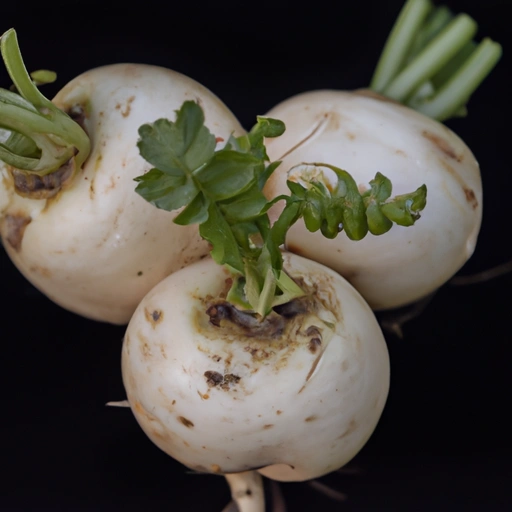Turnip
Description

The turnip is a root vegetable commonly grown in temperate climates worldwide. Known for its bulbous taproot, the turnip is a member of the Brassicaceae family, which includes cruciferous vegetables like broccoli, Brussels sprouts, and cabbage. Its scientific name is Brassica rapa subsp. rapa. This versatile veggie is not only prized for its root but also for its greens, which are equally nutritious and flavorful.
Common uses
Turnips are often used in a variety of dishes, particularly in stews, soups, and roasted vegetable medleys. They can also be mashed, sautéed, pickled, or consumed raw in salads. Turnip greens, the leafy top part of the plant, can be cooked similarly to spinach or collard greens, offering a slightly bitter, peppery flavor that complements many dishes.
Nutritional value
Calories
Turnips are low in calories, with a medium-sized turnip (122g or about 4.3oz) containing approximately 34 calories.
Protein
They offer about 1.1g of protein per medium-sized turnip, contributing to daily protein intake.
Fat
Turnips contain a negligible amount of fat, with less than 0.2g per medium-sized turnip.
Carbohydrates
Carbohydrates in a medium-sized turnip amount to around 7.8g, which includes dietary fiber that aids digestion.
Vitamins
Turnips are a good source of vitamin C, providing about 21mg, which is 35% of the recommended daily value (DV) in the American system. They also contain vitamins A, E, and several B vitamins.
Minerals
Essential minerals found in turnips include calcium (39mg), magnesium (14mg), potassium (233mg), and phosphorus (44mg), contributing to various bodily functions.
Health benefits
Turnips are rich in antioxidants, which can help reduce oxidative stress and lower the risk of chronic diseases. Their high fiber content promotes healthy digestion and may aid in weight management. The presence of vitamin C supports the immune system, while potassium helps maintain healthy blood pressure levels.
Potential risks
Turnips are generally safe for consumption; however, individuals with thyroid disorders should consume turnip greens in moderation due to their goitrogenic properties, which may interfere with thyroid hormone production. Additionally, individuals with kidney problems should be cautious of the high potassium content.
Common recipes
Turnips are utilized in a myriad of recipes, from the classic American turnip greens cooked with ham hocks to the French 'navet' dishes where turnips are glazed and served as a delicacy. In European cuisine, they are often featured in root vegetable roasts, mashed turnip side dishes, and hearty soups like the Scottish 'neeps and tatties.'
Cooking methods
Cooking methods for turnips include boiling, steaming, roasting, sautéing, and pickling. Turnip greens can be steamed, boiled, or sautéed and are often seasoned with garlic, lemon, or bacon.
Pairing with other ingredients
Turnips pair well with a variety of ingredients, including meats like pork and beef, other root vegetables, apples for a sweet contrast, and spices such as nutmeg or rosemary. Their greens complement fatty meats, grains, and legumes.
Summary
Turnips are a nutritious and versatile vegetable suitable for various culinary applications. With their historical significance and widespread use in global cuisines, they provide an excellent source of vitamins and minerals while also being low in calories. Whether you're looking to enhance a soup, create a comforting mash, or add some crunch to your salads, turnips are a valuable addition to any kitchen.